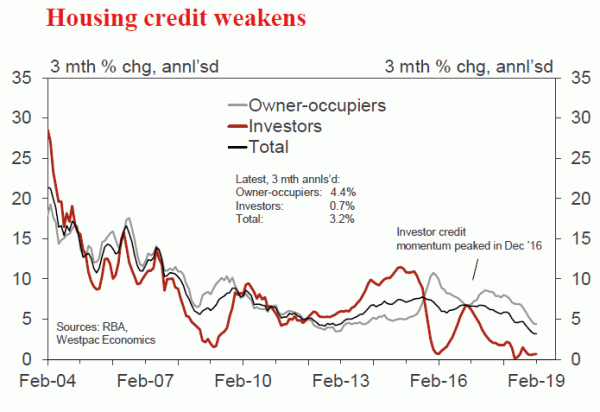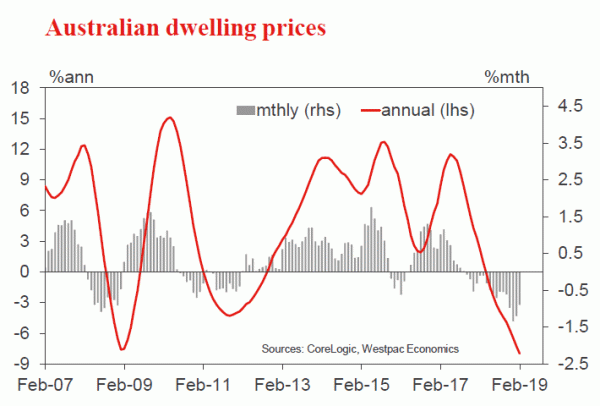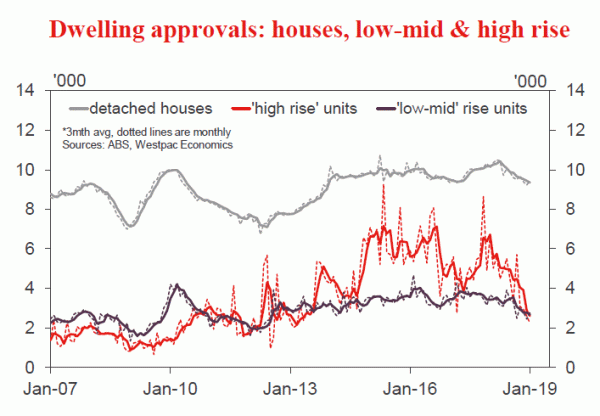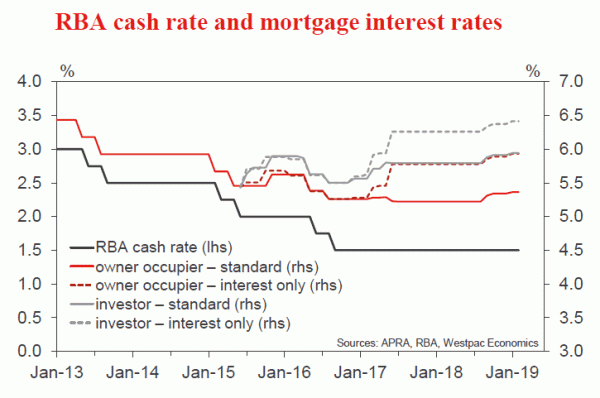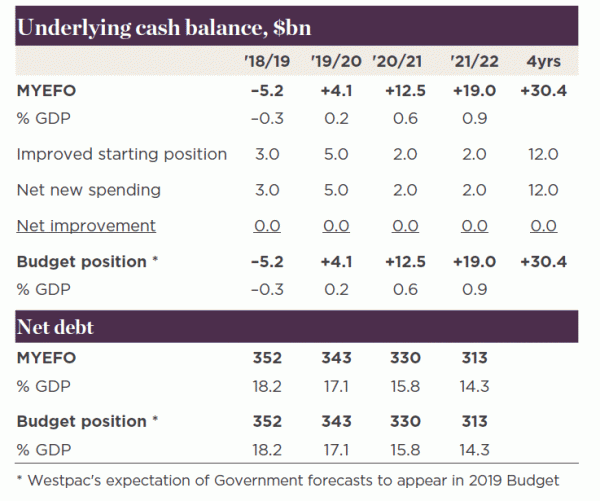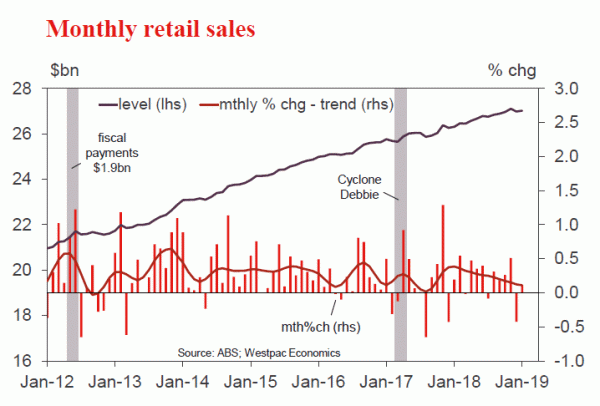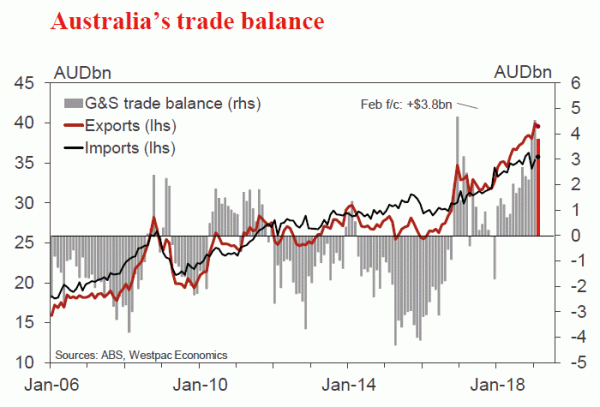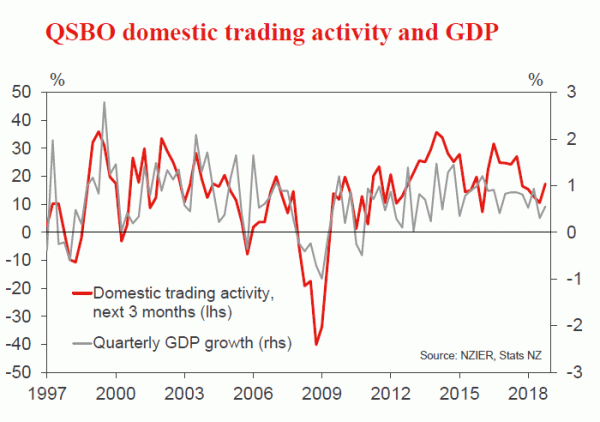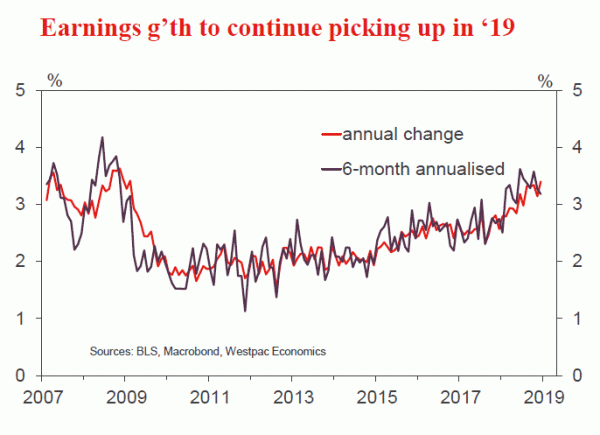Week beginning 1 April 2019
- Will the Federal Budget impact Monetary Policy?
- RBA policy decision.
- Australia: Federal budget, retail sales, dwelling prices and approvals, trade balance.
- NZ: Survey of Business Opinion.
- China: Caixin PMI’s.
- Europe: ECB minutes, unemployment rate, retail sales.
- US: non–farm payrolls, retail sales, ISM’s.
- Key economic & financial forecasts.
Information contained in this report current as at 29 March 2019.
Will the Federal Budget Impact Monetary Policy?
The Reserve Bank Board meets next week on April 2. Unusually, this meeting will be on the same day as the announcement of the Federal Budget at 7:30 pm on that evening. As such, we would expect that the Governor’s Statement will be fairly low key with little change from the sentiment we saw in the March meeting. As discussed, Westpac is anticipating that following the May meeting, the RBA will move to a clear easing bias, which will be justified by downward revisions in the growth forecasts. However, it is unlikely that there will be any hints of this action in the April Governor’s Statement. In the note below, we speculate on the implications of the Federal Budget for monetary policy.
In previous years the Reserve Bank has generally observed that fiscal policy has had only a very limited bearing on monetary policy decisions. It is reasonable to contemplate whether 2019 will be different.
Firstly, if we take the expected approach from the Budget (an expansionary budget with a focus on supporting households) then the Reserve Bank will be much more interested than in previous years.
We have estimated (see Federal Budget preview) that the government will have around $3bn to allocate before June 30; and $5bn in 2019/20. In addition there will be the $2.5bn in 2019/20 which was earmarked in MYEFO as “allocated but not announced”.
Taken together, $10.5bn represents 0.8% of households’ annual disposable income or around 1.0% of annual consumer spending. By way of context, ‘trend’ consumer spending is around 2.8% a year, or 0.7% per quarter, while in 2018 it grew by only 2.0%. In this analysis, we assume that of any boost to household income half is saved and half is spent.
We can speculate as to how the new policy measures may be delivered. If they all take the form of direct payments impacting in a single quarter, then this represents a sizeable injection. If for instance, the $3bn was paid in direct one–off payments to households in late 2018/19 (say end June) and the additional $7.5bn was also paid as direct payments in early 2019/20 (say July) there would be an immediate cumulative injection of $10.5bn, representing 3.5% of quarterly disposable income or 4% of quarterly consumer spending. On the basis that, say, half the payments were saved then total consumer spending could be expected to lift by around 2.7% in the quarter, well in excess of the “trend” of around 0.7%.
If instead the new policy measures are delivered as a more staggered mix of payments and tax cuts then the impact may be less dramatic. For instance, if the $3bn was paid as a lump sum (1.14% of quarterly consumption) in, say, June 2019 then consumer spending could lift by an additional 0.57% in the June quarter on the basis of saving half the payment.
If the additional $7.5bn was allocated to a tax cut which was spread over the year then disposable income growth would be boosted by 0.6% over the year and consumer spending (spend half the tax cut) would be boosted by 0.35%.
In addition to the $10.5bn we have identified above, we have to consider the $4.1bn which is estimated to be received by households in extra tax rebates (as set out in the 2018 Budget). However, the economic impact is unclear as this 2018 Budget initiative was fully funded by measures cracking down on the “black economy”. It may be that timing issues mean that, taken together, these new policies might give a one–off boost to spending.
However there are numerous complications to these calculations – suggesting that the ultimate impact on consumers and on the economy of the 2019 Federal Budget will be less than these estimates indicate.
Firstly it is highly unlikely that the government would budget for a $10.5bn “handout”. That is likely to be viewed as a lopsided approach. A mix of $3.0bn in “handouts” and $7.5bn in tax cuts, effective from July 1 2019, seems to be a more balanced approach.
A complication is around the effective timing of any new measures. It is uncertain as to whether new budget initiatives can be legislated before the election with both houses of Parliament only sitting for one day after the Budget announcement.
This full allocation of the $10.5bn to personal income tax cuts and cash payments looks extreme given the government’s need to consider other interest groups apart from households, including regional Australia and infrastructure and accelerated depreciation allowances to boost investment by small business.
From the perspective of GDP and employment this response in spending is also likely to have a substantial leakage through imports.
Then of course we have the election which is mooted in the press for May 11, or at the latest May 18.
The Opposition currently leads opinion polls convincingly.
If the Opposition chooses to support the Government’s tax cuts and handouts it may be possible to legislate before June 30. Delaying the handout to post June 30 would put the 2019/20 surplus in doubt (see our calculations in Federal Budget preview).
Alternatively, the Opposition may choose to only offer tax cuts which are funded by other taxes neutralising the net impact on incomes. Certainly their policies, if successfully implemented, could allow a revenue neutral tax cut, boosting their fiscal credentials or allowing more scope for other initiatives including health and education.
Our current timing for the RBA to move to an easing bias in May (before the election and before the impact of fiscal policy will be known) and a rate cut in August still seems to be the most likely scenario.
Any “bidding war” between the parties, particularly around one–off payments, is likely to be seen by the RBA as a temporary “sugar hit” that will not generate sustained higher income growth.
Tax cuts may allow the RBA to be a little more confident about the income/consumption outlook but that will be after it adjusts its current views to a much more realistic and lower growth trajectory as has become apparent through 2018 H2 and 2019.
With so much uncertainty about the impact of fiscal policy and the negative forces around housing; rising savings rates; low inflation and softening global growth building over the next months the RBA is still likely to move in August particularly now that the move is fully priced in to markets.
The week that was
Early in the week, Assistant Governor (Economic) Luci Ellis highlighted that the RBA believe household income will continue to dictate the pace of consumption growth. The acceleration in wages growth from its low is fledgling, but a positive sign for the Bank nonetheless – particularly given their expectation of robust employment gains hence.
Other factors however linger as headwinds for non–labour (non–wage) income: “[s]ocial assistance payments have been relatively flat for a number of years”; rental income growth has softened; and unincorporated business income has been weak, in part due to the drought but also because real estate activity is deteriorating. A rising tax take is also a factor, restricting gains for disposable income and thus spending. The take home from the above is that the RBA remain optimistic that disposable income growth will strengthen, but acknowledge progress will remain slow.
Whereas the RBA see a wealth effect from housing as only having a narrow impact on vehicle sales and home furnishing demand, Westpac continues to believe that the effect will be broader, holding consumption growth well below trend through 2019 and 2020. To our mind, as laid out in our previews, even an expansionary Federal Budget 2019 is unlikely to change the narrative for growth or the need for the RBA to lower the cash rate.
Over in New Zealand this week, the RBNZ followed the lead of other major global central banks and took a more dovish stance. The RBNZ now see “the more likely direction of the next OCR move [as] down” and the balance of risks as having “shifted to the downside”. This change is despite core economic data having remained robust, and the currency holding in line with their expectations. As laid out by our New Zealand team, the RBNZ may be concerned about the potential for a higher currency to suppress inflation, and/or that the domestic economy may not pick up enough to boost inflation.
Turning to the northern hemisphere, FOMC speakers have, in effect, repeated Chair Powell message from last week, highlighting risks and the prudence of patience in uncertain times despite a broad consensus that US GDP growth will remain above trend in 2019.
In Europe, the particularly weak manufacturing PMI outcomes of last Friday were not followed by sharp falls in other business surveys (the IFO up slightly; while EC business climate was down a touch) but remain a concern. While overall, that did not elicit a further dovish shift from President Draghi this week, he did discuss potentially acting to mitigate negative policy rates’ impact on bank profitability “if necessary”. Reports of internal discussions regarding the potential introduction of a tiered deposit rate on excess reserves supported the idea of a reduced burden for the sector, and more generally, the potential for negative rates to be maintained even longer. However, ECB Chief Economist Praet subsequently noted that this would only occur if a solid monetary–policy case developed, and there were mixed reactions among the other Governing Council members.
Finally in the UK, in the lead–up to Parliament taking control of the Brexit debate and tabling a series of ‘indicative votes’ on alternative proposals, PM May announced to MPs that she would resign if her withdrawal deal is passed. The indicative votes ended up being another political move with nil benefit, with all the proposals brought before Parliament voted down. Part of PM May’s deal (the withdrawal treaty) is reportedly still set to be voted down for a third time this Friday despite PM May’s offer to resign.
Chart of the week: Australian credit growth
Credit growth has moderated to a slow pace led by the housing downturn.
The softness in credit evident at the turn of the year has continued into 2019. Credit grew by 0.24% in December, rose by 0.22% in January and then increased by 0.26% in February.
Annual growth edged lower to 4.2% – the lowest nominal growth rate in the series history dating back to 1976.
New Zealand: week ahead & data wrap
A new era
It was a pivotal week for the Reserve Bank of New Zealand, which delivered a surprising shift in its monetary policy stance. Our current forecast is for the Official Cash rate to remain on hold over the next few years, but the risks of a rate cut at upcoming reviews, including the next Monetary Policy Statement in May, are very much live. From hereon those decisions will be made by a formal committee, with external and internal members.
This week’s OCR review broke decisively from the RBNZ’s previous statements, which had noted that the next move could be either up or down. The RBNZ now believes that the balance of risks to the economic outlook “has shifted to the downside,” and that “the more likely direction of the next OCR move is down.”
This change in stance surprised us as the economic situation hasn’t changed a lot since the last OCR review in February. Recent GDP data showed that the domestic economy has kept ticking over, with solid growth in consumer spending and construction. Global growth has softened, but not significantly, and the consequences for the New Zealand economy have not been obvious – in fact, our export commodity prices have been strengthening recently.
What has changed a lot since February, however, is market sentiment on interest rates. In the midst of some mixed economic data, overseas central banks have either shifted to more dovish monetary policy outlooks, or are expected to do so. The RBNZ was apparently concerned that if it didn’t join the flock, there could be an undesirable rise in the New Zealand dollar, which would suppress inflation and ultimately force the RBNZ to change its stance anyway.
The other surprising aspect of the RBNZ’s statement was the emphasis placed on softer domestic spending and weak business sentiment. We have long thought that the RBNZ was too optimistic on economic growth, and hence too bullish on the extent of a pickup in domestically–generated inflation. While the December quarter GDP result wasn’t significantly below the RBNZ’s forecast (0.6% vs 0.8%), it may have been the last straw that triggered a change in sentiment. Recent personnel changes within the RBNZ might have also been a factor in the sudden change of view.
The thinking in financial markets has now turned to whether the RBNZ will actually cut the OCR, and if so, when. We’re taking the RBNZ’s statement at face value: the risks have shifted to the downside. The RBNZ is leaving open the option of cutting the OCR if required, rather than signalling that a cut is imminent.
That said, it does mean that every upcoming OCR review, including the next Monetary Policy Statement in May, is ‘live’. Much will depend on the flow of data from both here and overseas in the coming weeks.
On the global front at least, we don’t expect sentiment to turn around again in a hurry. We think that the market has become too downbeat on the US economy, which is running at close to full employment and is now seeing a notable pickup in wage pressures. But the US Federal Reserve itself has taken rate hikes off the table for now, and it will need to see an accumulation of evidence before it changes its mind again. Meanwhile, we do expect the Reserve Bank of Australia to move toward rate cuts this year, albeit under very different conditions to what the RBNZ is facing.
In terms of the domestic economy, the RBNZ has highlighted weak business sentiment and the risk that this flows through into domestic demand. This week we saw a further drop in the ANZ business confidence survey for March, reversing most of the modest recovery that occurred at the end of last year. Hiring and investment intentions, as well as profit expectations were all lower.
We’ll also be taking a close look at next Tuesday’s Quarterly Survey of Business Opinion. This tends to be the single best early indicator of quarterly GDP growth, and it also provides useful insights on the capacity constraints and cost pressures that businesses are facing. The Tax Working Group’s recent recommendation to introduce a capital gains tax could weigh on sentiment this time. But beneath the headline, the QSBO will give a valuable read on whether the economy is picking up enough for the RBNZ to avoid cutting.
Actual domestic demand may be stronger these confidence surveys suggest. Electronic card spending has continued to grow at a solid pace, government spending is increasing as planned, and imports of capital equipment have picked up in the early part of this year. Dwelling consents have continued to rise to multi–decade highs, indicating a strong pipeline of building work over the next year or so. Our view remains that growth will pick up in 2019 after a softer patch in the second half of 2018.
The other major monetary policy announcement this week was the membership of the RBNZ’s new decision–making committee, which comes into effect from next week. The committee consists of four internal members, including the Governor and senior management, and three external members. The external members that were announced this week are all experienced economists, with respective backgrounds in agriculture, macroeconomics and the labour movement.
These appointments should dampen any concerns that the external committee members will be cowed by the RBNZ internals due to a lack of experience. They will all be quite capable of critiquing the RBNZ’s analysis and holding their own in a debate about economics. As for how they might shift the balance of the RBNZ’s decisions, the answer is less clear. In particular, they may well have differing views on how to balance the RBNZ’s new dual mandate, which focuses on supporting maximum sustainable employment as well as price stability.
Data Previews
Aus Mar CoreLogic home value index
- Apr 1, Last: –0.9%, WBC f/c: –0.7%
The Australian housing market’s very weak finish to 2018 has carried into early 2019, albeit with some tentative signs that the pace of price declines may be easing. The CoreLogic home value index recorded a 0.9% fall in February following average falls of 1.2% over the previous three months.
The daily index points to a 0.7% fall for the March month, which would be the mildest decline since October. The cumulative decline since late 2017 will be close to 10%.
Aus Feb dwelling approvals
- Apr 2, Last: 2.5%, WBC f/c: –1.0%
- Mkt f/c: –1.8%, Range: –5.0% to 3.0%
Dwelling approvals posted a 2.5% lift in Jan, paring back some of the dramatic weakening seen in late 2018 – approvals slid over 25% through the last three months of 2018.
High rise approvals are now back to multi–year lows, Jan the weakest read since March 2013. Current levels are now around those that prevailed prior to the boom, hence some stabilisation looks likely from here. Meanwhile construction– related finance approvals are also suggesting the weakening in non–high rise approvals is starting to moderate, although this is more likely to show through in coming months. On balance, Feb is expected to see some residual weakness with a 1% decline in total approvals.
Aus RBA policy decision
- Apr 2, Last: 1.50%, WBC f/c: 1.50%
- Mkt f/c: 1.50%, Range: 1.25% to 1.50%
The Reserve Bank Board meets next week on April 2. Unusually, this meeting will be on the same day as the announcement of the Federal Budget at 7:30 pm on that evening. As such, we would expect that the Governor’s Statement will be fairly low key with little change from the sentiment we saw in the March meeting.
As discussed, Westpac is anticipating that following the May meeting, the RBA will move to a clear easing bias, which will be justified by downward revisions in the growth forecasts. However, it is unlikely that there will be any hints of this action in the April Governor’s Statement. In the note on page 2, we speculate on the implications of the Federal Budget for monetary policy.
Aus 2019 Federal Budget, AUDbn
- Apr 2, Last: –5.2(e), WBC f/c: +4.1
Federal Budget 2019 will reveal an improved starting position for the budget relative to that in the December Mid–Year Economic & Fiscal Outlook (MYEFO).
Spending is running below forecasts in 2018/19, in part due to stronger than anticipated jobs growth to date.
For 2019/20, the size of the nominal economy is likely to be $10bn larger than anticipated in MYEFO because of upside surprises on commodity prices. This boosts revenue, by around $3bn, plus spending is likely to be running around $2bn below forecast – a combined improvement of $5bn.
The upside surprise to the budget is likely, in our view, to be returned to the people in tax cuts and increased spending. Hence the profile for the budget balance is as in MYEFO.
Aus Feb retail trade
- Apr 3, Last: 0.1%, WBC f/c: –0.1%
- Mkt f/c: 0.3%, Range: –0.1% to 0.6%
Australian retailers continue to see very difficult conditions. Sales rose just 0.1% in Jan, a disappointing result following the 0.4% fall in Dec, annual growth slowing to 2.7%yr but tracking at a 2% annualised pace over the last six months. The detail showed gains were confined to food sub–categories – both basic food and cafes & restaurants up 0.3%mth – with non food categories down 0.1%mth.
Consumer sentiment had a shaky start to 2019, dipping into net pessimistic territory for the first time since 2017, recovering in Feb but falling back again in March, the survey detail also showing very high levels of risk aversion. Private sector business surveys point to a further significant weakening in conditions for retailers in Feb. While these measures are not good enough to generate month to month point forecasts for retail sales, they are consistent with outright falls. As such we expect Feb to show a 0.1% decline, taking annual sales growth to 2%.
Aus Feb trade balance, AUDbn
- Apr 3, Last: 4.5, WBC f/c: 3.8
- Mkt f/c: 3.7, Range: 2.4 to 5.0
The trade account was in surplus for the past 13 months.
In January, the surplus soared to $4.5bn (the 2nd largest on record), with exports +5.0% and imports +3.3%.
For February, we expect a pull–back to a still sizeable surplus of $3.8bn.
Imports are forecast to rise by a further 1.1%, +$0.38bn, with the potential for fuel to lift following a softer month.
Exports slip by a forecast 0.9%, –$0.36bn, with sizeable falls in gold and coal outweighing a surge in iron ore.
Gold exports are expected to pull–back sharply, –45%, down $1.0bn, off a high base pre–Lunar New Year. Coal earnings are expected to slump by almost 10%, –$0.5bn on a sharp drop in volumes. By contrast, metal ore export earnings are expected to surge, by more than 10%, +$1.1bn, on the jump in the iron ore price to US$85/t.
NZ Q1 Survey of Business Opinion
- Apr 2, General business situation, Last: –18
- Domestic trading activity, Last: +17
General business confidence and firms’ expectations for their own activity both picked up in the final months of 2018. Nevertheless, the key gauges of business activity in the NZIER’s quarterly survey of business opinion remained at low levels in December.
Since the December quarter survey, monthly gauges of business confidence have softened again, and we expect this will be reflected in the March quarter result. GDP growth slowed through the back half of 2018. We’ve also heard increased concern from some businesses about the potential introduction of a capital gains tax.
The survey is closely watched as an indicator of inflation. Firms have been noting pressure on margins, with rising costs (especially for wages) but limited ability to pass this on due to competitive pressures.
US Mar employment report
- Apr 5, nonfarm payrolls, last 20k, WBC 185k
- Apr 5, unemployment rate, last 3.8%, WBC 3.8%
- Apr 5, hourly earnings, last 3.4%yr, WBC 3.4%yr
The Feb 2019 nonfarm payrolls result came as a significant shock to the market, coming in at just 20k. Still, for the year– to–date, the average monthly gain is robust at 166k. Come Mar, we look for a 185k gain to keep month–average growth around 170k. There is however a material risk of significant positive revisions to Feb, and hence of a softer Mar.
While the unemployment rate will most likely be unchanged at 3.8% in Mar, the trend remains downward. On our expectations, 3.5% could be seen in the second half of 2019.
Hourly earnings will remain a focus in coming months. At 3.4%yr, wages growth is well up on its lows, but still not indicative of a ‘hot’ labour market. This modest uptrend should persist through 2019, to near 4.0%yr.




